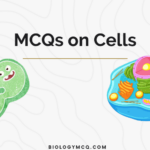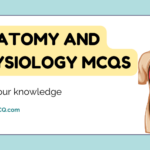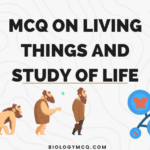Study and Learn with 1000s of Biology MCQs
Hormones MCQs

Hormones MCQ – Our collection of multiple-choice questions on hormones explores the different types of hormones, their sources, functions, and mechanisms of action.
Topics covered include the endocrine system, hormone secretion, hormonal regulation of metabolism, growth and development, reproductive functions, and stress response.
Answering these MCQs will not only help you understand the role of hormones in maintaining physiological balance but also deepen your knowledge of endocrinology and human biology.
Ready to explore the fascinating world of hormones? Let’ get started!
MCQ on Hormones
The _____is the system that handles hormone production and secretion within an organism
endocrine system
Digestive system
Nervous systemPituitary gland produces
Circulatory system
endocrine system
_ keeps a check on cellular processes and components of the bloodstream and can make adjustments as necessary
Digestive system
Nervous system
Circulatory system
endocrine system
endocrine system
Example/s of exocrine gland secretions are _
sweat
saliva
Both of these
None of these
Both of these
Sweat and saliva are examples of _
exocrine gland secretions
endocrine gland secretions
Both of these
None of these
exocrine gland secretions
Hormones in vertebrates can be divided into _ groups
3
6
8
2
2
Insulin is _
Steroid hormone
Peptide hormone
Both of these
None of these
Peptide hormone
_ are short chains of amino acids
Steroid hormones
Peptide hormones
Both of these
None of these
Peptide hormone
_ are hydrophilic (water loving)
Peptide hormones
Steroid hormones
Both of these
None of these
Peptide hormones
_ don’t pass easily through cell membranes
Peptide hormone
Steroid hormone
Both of these
None of these
Peptide hormone
since the message from the hormone is passed through the plasma membrane, this signaling process is called?
signal transcription
signal translation
signal transduction
signal transfer
signal transduction
testosterone and estrogen are _
Peptide hormones
Steroid hormones
Both of these
None of these
Steroid hormones
_ are lipids
Peptide hormones
Steroid hormones
Both of these
None of these
Steroid hormones
Steroid hormones are _
Carbohydrates
Vitamins
Proteins
lipids
lipids
Peptide hormones are _
Carbohydrates
Vitamins
Amino acids
Lipids
Amino acids
_ are hydrophobic
Peptide hormones
Steroid hormones
Both of these
None of these
Steroid hormones
_ can pass easily through the hydrophobic layer of the plasma membrane and enter cells
Steroid hormones
Peptide hormones
Both of these
None of these
Steroid hormones
functions of hormones include _
Making sure that reproduction occurs at the best possible time
Ensuring that development and maturation occur properly and on time
Assuring that growth occurs properly
All of these
All of these
the shedding of the outer layer in invertebrates is called?
Molting
Inflammation
accomodation
None of these
Molting
the process of changing body forms during developmental stages in insects is called?
Molting
Inflammation
accomodation
metamorphosis
metamorphosis
In insects, the process of changing body forms during developmental stages is controlled by a substance called _ hormone
Estrogen
testosteron
juvenile
insulin
juvenile
__ is the process that changes a larva or caterpillar into a pupa and then into a moth or a butterfly
Molting
Inflammation
accomodation
metamorphosis
metamorphosis
Adrenaline is produced by _
Adrenal gland
Ovaries
testes
Pineal gland
Adrenal gland
Aldosterone is produced by _
Adrenal gland
Ovaries
testes
Pineal gland
Adrenal gland
Antidiuretic hormone is produced by?
Ovaries
testes
Pituitary gland
Pineal gland
Pituitary gland
Estrogen is produced by?
Ovaries
testes
Pituitary gland
Pineal gland
Ovaries
Follicle-stimulating hormone (FSH) is produced by?
Ovaries
testes
Pituitary gland
Pineal gland
Pituitary gland
Glucagon is produced by?
Ovaries
pancreas
Pituitary gland
Pineal gland
pancreas
Growth harmone is produced by?
Ovaries
pancreas
Pituitary gland
Pineal gland
Pituitary gland
Insulin is produced by?
Ovaries
pancreas
Pituitary gland
Pineal gland
pancreas
Luteinizing hormone (LH) is produced by?
Ovaries
pancreas
Pituitary gland
Pineal gland
Pituitary gland
Melatonin is produced by?
Ovaries
pancreas
Pituitary gland
Pineal gland
Pineal gland
Oxytocin is produced by?
Ovaries
pancreas
Pituitary gland
Pineal gland
Pituitary gland
progesterone is produced by?
Ovaries
pancreas
Pituitary gland
Pineal gland
Ovaries
Prolactin is produced by?
Ovaries
pancreas
Pituitary gland
Pineal gland
Pituitary gland
Testosterone is produced by?
Ovaries
testes
Pituitary gland
Pineal gland
testes
Thyroid-stimulating hormone is produced by?
Ovaries
testes
Pituitary gland
Pineal gland
Pituitary gland
Thyroxine is produced by?
Ovaries
testes
Pituitary gland
thyroid gland
thyroid gland
Adrenal gland produces __?
Glucagon
Follicle-stimulating hormone (FSH)
Estrogen
Adrenaline
Adrenaline
Adrenal gland produces __?
Glucagon
Aldosterone
Follicle-stimulating hormone (FSH)
Estrogen
Aldosterone
Pituitary gland produces __?
Glucagon
Aldosterone
Follicle-stimulating hormone (FSH)
Estrogen
Follicle-stimulating hormone (FSH)
ovaries produce __?
Glucagon
Aldosterone
Follicle-stimulating hormone (FSH)
Estrogen
Estrogen
Pituitary gland produces __?
Glucagon
Aldosterone
Growth hormone
Estrogen
Growth hormone
Pituitary gland produces __?
Luteinizing hormone(LH)
Glucagon
Aldosterone
Estrogen
Luteinizing hormone(LH)
Pituitary gland produces __?
Glucagon
Aldosterone
Oxytocin
Estrogen
Oxytocin
Pituitary gland produces __?
Glucagon
Aldosterone
prolactin
Estrogen
prolactin
Pituitary gland produces __?
Thyroid-stimulating hormone
Glucagon
Aldosterone
Estrogen
Thyroid-stimulating hormone
Pineal gland produces __?
Thyroid-stimulating hormone
Glucagon
melatonin
Estrogen
melatonin
Ovaries produce _
Thyroid-stimulating hormone
Glucagon
melatonin
Progesterone
Progesterone
testes produce _
Thyroid-stimulating hormone
testosterone
melatonin
Progesterone
testosterone
Thyroid gland produces _
Thyroid-stimulating hormone
testosterone
thyroxine
Progesterone
thyroxine
Function of adrenaline is?
Stimulates growth of the uterine lining; triggers and maintains secondary sex characteristics in females
Signals kidneys to retain water
Regulates the balance of salt and water in the body by causing kidneys to reabsorb sodium and release potassium
Increases metabolism and glucose in the blood; constricts some blood vessels
Increases metabolism and glucose in the blood; constricts some blood vessels
Function of Aldosterone is?
Stimulates growth of the uterine lining; triggers and maintains secondary sex characteristics in females
Signals kidneys to retain water
Regulates the balance of salt and water in the body by causing kidneys to reabsorb sodium and release potassium
Increases metabolism and glucose in the blood; constricts some blood vessels
Regulates the balance of salt and water in the body by causing kidneys to reabsorb sodium and release potassium
Function of Antidiuretic hormone is?
Stimulates growth of the uterine lining; triggers and maintains secondary sex characteristics in females
Signals kidneys to retain water
Regulates the balance of salt and water in the body by causing kidneys to reabsorb sodium and release potassium
Increases metabolism and glucose in the blood; constricts some blood vessels
Signals kidneys to retain water
Function of estrogen is?
Stimulates growth of the uterine lining; triggers and maintains secondary sex characteristics in females
Signals kidneys to retain water
Regulates the balance of salt and water in the body by causing kidneys to reabsorb sodium and release potassium
Increases metabolism and glucose in the blood; constricts some blood vessels
Stimulates growth of the uterine lining; triggers and maintains secondary sex characteristics in females
Function of Follicle-stimulating hormone (FSH) is?
Stimulates production of eggs and sperm
Stimulates growth of the uterine lining; triggers and maintains secondary sex characteristics in females
Regulates the balance of salt and water in the body by causing kidneys to reabsorb sodium and release potassium
Increases metabolism and glucose in the blood; constricts some blood vessels
Stimulates production of eggs and sperm
Function of glucagon is?
Stimulates growth of the uterine lining; triggers and maintains secondary sex characteristics in females
Regulates the balance of salt and water in the body by causing kidneys to reabsorb sodium and release potassium
Raises glucose (sugar) in the blood
Increases metabolism and glucose in the blood; constricts some blood vessels
Raises glucose (sugar) in the blood
Function of growth harmone is?
Stimulates growth of the uterine lining; triggers and maintains secondary sex characteristics in females
Regulates the balance of salt and water in the body by causing kidneys to reabsorb sodium and release potassium
Raises glucose (sugar) in the blood
Stimulates growth of bones; promotes metabolic functions
Stimulates growth of bones; promotes metabolic functions
Function of insulin is?
Stimulates growth of the uterine lining; triggers and maintains secondary sex characteristics in females
Lowers glucose (sugar) in the blood
Raises glucose (sugar) in the blood
Stimulates growth of bones; promotes metabolic functions
Lowers glucose (sugar) in the blood
Function of luteinizing hormone (LH) is?
Stimulates growth of the uterine lining; triggers and maintains secondary sex characteristics in females
Stimulates ovaries and testes
Raises glucose (sugar) in the blood
Stimulates growth of bones; promotes metabolic functions
Stimulates ovaries and testes
Function of melatonin is?
Regulates sleep and wake cycles
Stimulates ovaries and testes
Raises glucose (sugar) in the blood
Stimulates growth of bones; promotes metabolic functions
Regulates sleep and wake cycles
Function of oxytocin is?
Regulates sleep and wake cycles
Stimulates ovaries and testes
Raises glucose (sugar) in the blood
Triggers contraction of the uterus and mammary glands (to release milk)
Triggers contraction of the uterus and mammary glands (to release milk)
Function of progesterone is?
Regulates sleep and wake cycles
Stimulates ovaries and testes
Supports growth of the uterine lining
Triggers contraction of the uterus and mammary glands (to release milk)
Supports growth of the uterine lining
Function of prolactin is?
Stimulates milk production
Stimulates ovaries and testes
Supports growth of the uterine lining
Triggers contraction of the uterus and mammary glands (to release milk)
Stimulates milk production
Function of testosterone is?
Stimulates milk production
Stimulates sperm formation; triggers and maintains secondary sex characteristics in males
Supports growth of the uterine lining
Triggers contraction of the uterus and mammary glands (to release milk)
Stimulates sperm formation; triggers and maintains secondary sex characteristics in males
Function of thyroid stimulating harmone is?
Stimulates milk production
Stimulates sperm formation; triggers and maintains secondary sex characteristics in males
Supports growth of the uterine lining
Stimulates the thyroid gland
Stimulates the thyroid gland
Function of thyroxine is?
Stimulates and maintains metabolism
Stimulates sperm formation; triggers and maintains secondary sex characteristics in males
Supports growth of the uterine lining
Stimulates the thyroid gland
Stimulates and maintains metabolism
_ Increases metabolism and glucose in the blood; constricts some blood vessels
Estrogen
Antidiuretic hormone
Aldosterone
Adrenaline
Adrenaline
_ Regulates the balance of salt and water in the body by causing kidneys to reabsorb sodium and release potassium
Estrogen
Antidiuretic hormone
Aldosterone
Adrenaline
Aldosterone
_ Signals kidneys to retain water
Estrogen
Antidiuretic hormone
Aldosterone
Adrenaline
Antidiuretic hormone
_ Stimulates growth of the uterine lining; triggers and maintains secondary sex characteristics in females
Estrogen
Antidiuretic hormone
Aldosterone
Adrenaline
Estrogen
_ Stimulates production of eggs and sperm
Antidiuretic hormone
Follicle-stimulating hormone
Aldosterone
Adrenaline
Follicle-stimulating hormone
_ Raises glucose (sugar) in the blood
Aldosterone
Adrenaline
insulin
glucagon
glucagon
_ Stimulates growth of bones; promotes metabolic functions
Adrenaline
insulin
glucagon
Growth hormone
Growth hormone
_ Lowers glucose (sugar) in the blood
Adrenaline
insulin
glucagon
Growth hormone
insulin
_ Stimulates ovaries and testes
Luteinizing hormone (LH)
insulin
glucagon
Growth hormone
Luteinizing hormone (LH)
_ Regulates sleep and wake cycles
insulin
glucagon
Melatonin
Growth hormone
Melatonin
_ Triggers contraction of the uterus and mammary glands (to release milk)
Growth hormone
insulin
Glucagon
Oxytocin
Oxytocin
_ Supports growth of the uterine lining
insulin
Progesterone
Glucagon
Oxytocin
Progesterone
_ Stimulates milk production
Progesterone
Glucagon
prolactin
Oxytocin
prolactin
_ Stimulates sperm formation; triggers and maintains secondary sex characteristics in males
testosteron
Glucagon
prolactin
Oxytocin
testosteron
_ Stimulates the thyroid gland
Glucagon
Thyroid-stimulating hormone
prolactin
Oxytocin
Thyroid-stimulating hormone
_ Stimulates and maintains metabolism
prolactin
Oxytocin
insulin
Thyroxine
Thyroxine



